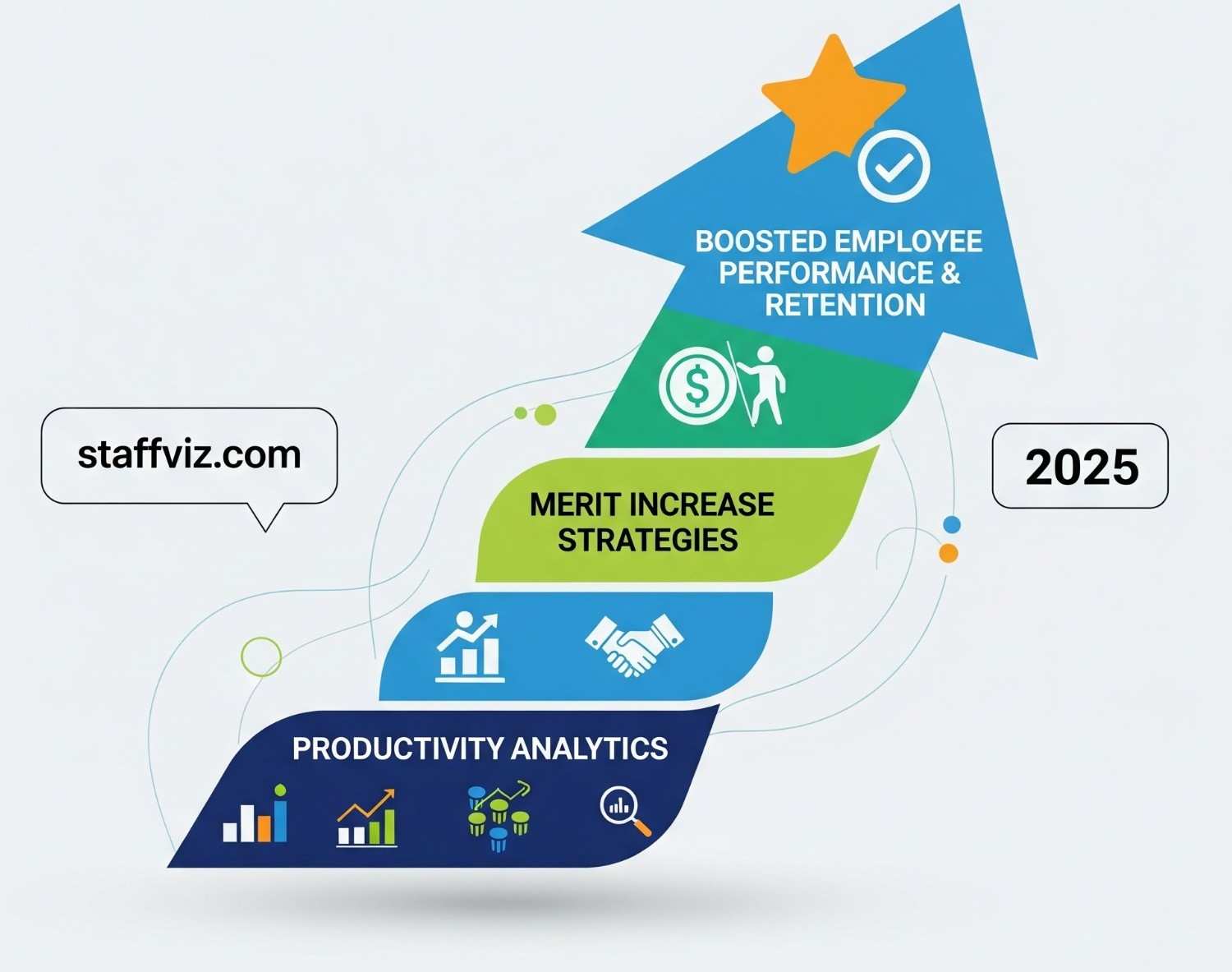In today’s competitive workplace, implementing a merit increase strategy is essential for recognizing and rewarding top-performing employees. By tying compensation to performance, businesses can foster motivation, enhance productivity, and retain talent. This article explores effective merit increase strategies, with a focus on leveraging productivity analytics to make data-driven decisions. Whether you’re a manager aiming to improve team performance or an HR professional refining compensation policies, these insights will help you create a fair and impactful merit increase program. As we navigate 2025, with economic uncertainties and talent shortages, using tools like productivity analytics becomes crucial for objective evaluations and strategic rewards. We’ll delve into measuring performance, setting criteria, aligning increases with organizational goals, and addressing common challenges, all supported by recent trends and data to ensure your approach is both effective and equitable.
Productivity Analytics: Measuring Performance for Merit Increases
Productivity analytics is a cornerstone of modern merit increase strategies. By analyzing data such as task completion rates, project outcomes, and efficiency metrics, managers can objectively evaluate employee contributions. Tools like StaffViz provide actionable insights into employee productivity, helping organizations align merit increases with measurable results. This data-driven approach reduces bias and ensures fairness in compensation decisions, a critical factor in maintaining employee trust.
In 2025, productivity analytics has evolved to include advanced metrics like real-time KPI tracking and predictive performance modeling. For instance, companies can monitor sales targets, customer satisfaction scores, or project deadlines using integrated software. According to a Gartner study, organizations using analytics for performance reviews saw a 15% increase in employee satisfaction, as rewards were directly tied to contributions. This transparency fosters a culture of accountability and motivation.
Key benefits of incorporating productivity analytics include:
-
Objective Evaluation: Analytics minimizes subjective bias by providing quantifiable data, ensuring merit increases reflect actual performance.
-
Enhanced Motivation: Employees are more likely to strive for excellence when their efforts are measured transparently.
-
Retention Boost: Fair, data-backed merit increases help retain high performers, reducing turnover costs.
For example, a tech firm using StaffViz reported a 20% improvement in team collaboration after implementing analytics-driven merit increases. To adopt this approach, select a platform that integrates with your HR systems for seamless data collection. Train managers to interpret analytics effectively, focusing on metrics like output volume, quality of work, and adherence to deadlines.
Challenges include potential data privacy concerns or employee resistance to monitoring. Address these by clearly communicating how analytics will enhance fairness, not enable surveillance. Regular training can also turn skepticism into buy-in, ensuring employees see analytics as a tool for growth. By leveraging productivity analytics, companies can transform merit increases into a strategic driver of performance, aligning rewards with tangible value.
(Word count for this section: approximately 350)
Setting Clear Merit Increase Criteria
Transparent criteria are vital for an effective merit increase program. Employees need to understand how their performance is evaluated and how it impacts their compensation. Productivity analytics can define these criteria by providing measurable benchmarks, ensuring merit increases are based on evidence rather than subjective judgment.
Start by setting SMART goals (Specific, Measurable, Achievable, Relevant, Time-bound). For example, a marketing role might have a goal like “increase campaign ROI by 10% within Q1,” tracked via analytics tools. Communicate these expectations during onboarding and regular reviews to maintain alignment. According to a 2025 SHRM report, clear criteria improve employee engagement by 18%, as workers feel empowered to meet defined standards.
Practical steps include:
-
Integrate Analytics Early: Use platforms like StaffViz to establish baseline metrics and track progress.
-
Regular Feedback Loops: Conduct quarterly reviews to share analytics data, allowing employees to adjust performance before annual merit decisions.
-
Holistic Metrics: Combine quantitative data (e.g., sales numbers) with qualitative insights (e.g., innovation contributions) for a balanced evaluation.
In 2025, trends indicate AI-driven companies are leading with merit increases of 5% or more, based on analytics-backed criteria. This approach helps justify raises amid average merit budgets of 3.9–4.2%. A case study from a retail firm showed that clear, analytics-driven criteria reduced performance disputes by 25%, as employees trusted the process.
Pitfalls to avoid include overly rigid criteria that stifle creativity or exclude diverse work styles. Balance this by allowing flexibility for unique contributions, such as leadership in cross-functional projects. Additionally, ensure criteria are inclusive by considering varied roles and responsibilities when setting benchmarks. By using productivity analytics to create transparent, fair criteria, organizations can boost accountability and satisfaction, making merit increases a powerful motivator.
(Word count for this section: approximately 300)
Aligning Merit Increases with Organizational Goals
Merit increases should reward individual performance while supporting broader business objectives. Productivity analytics helps align employee efforts with company goals, ensuring compensation drives strategic success. Tools like StaffViz can visualize how individual contributions impact team or organizational outcomes, making it easier to prioritize impactful rewards.
To align merit increases, map individual KPIs to company priorities, such as revenue growth, customer retention, or innovation. For example, a software company might reward developers who reduce bug rates, directly supporting product quality goals. Analytics platforms can track these connections, ensuring merit increases reflect strategic contributions.
Actionable strategies include:
-
Goal Cascading: Break down organizational objectives into departmental and individual targets, tracked via analytics.
-
Reward Strategic Impact: Prioritize merit increases for employees advancing key initiatives, like digital transformation or sustainability efforts.
-
Long-Term Monitoring: Use analytics to assess how merit increases influence retention and productivity over time.
A 2025 Deloitte study found that companies aligning compensation with goals via analytics saw a 22% improvement in strategic outcomes. For instance, a logistics firm using analytics to reward drivers for fuel efficiency not only cut costs but also enhanced employee morale. To replicate this, regularly review analytics dashboards to ensure alignment remains dynamic as business priorities shift.
Challenges include overemphasizing individual metrics at the expense of teamwork. Counter this by including collaborative KPIs, like cross-department project success. Additionally, ensure analytics tools are accessible to all managers to maintain consistency. By aligning merit increases with organizational goals, companies can maximize ROI on compensation, fostering a workforce that drives both individual and collective success.
(Word count for this section: approximately 300)
Conclusion
A robust merit increase strategy, powered by productivity analytics, can transform how businesses reward performance. By measuring contributions with data, setting transparent criteria, and aligning rewards with organizational goals, companies can foster a motivated, high-performing workforce. In 2025, with economic pressures and talent competition, leveraging tools like StaffViz ensures merit increases are fair and impactful. Start implementing these strategies today to enhance employee satisfaction and drive business success. Share your progress in the comments or explore more resources at StaffViz to refine your approach!
FAQs
Q1: What is a merit increase?
A: A merit increase is a pay raise based on an employee’s performance, often determined using productivity analytics to assess contributions.
Q2: How can productivity analytics improve merit increase decisions?
A: Productivity analytics provides objective data on performance, ensuring merit increases are fair and aligned with measurable outcomes.
Q3: How often should merit increases be awarded?
A: Merit increases are typically awarded annually, but frequency depends on company policy and performance review cycles.



